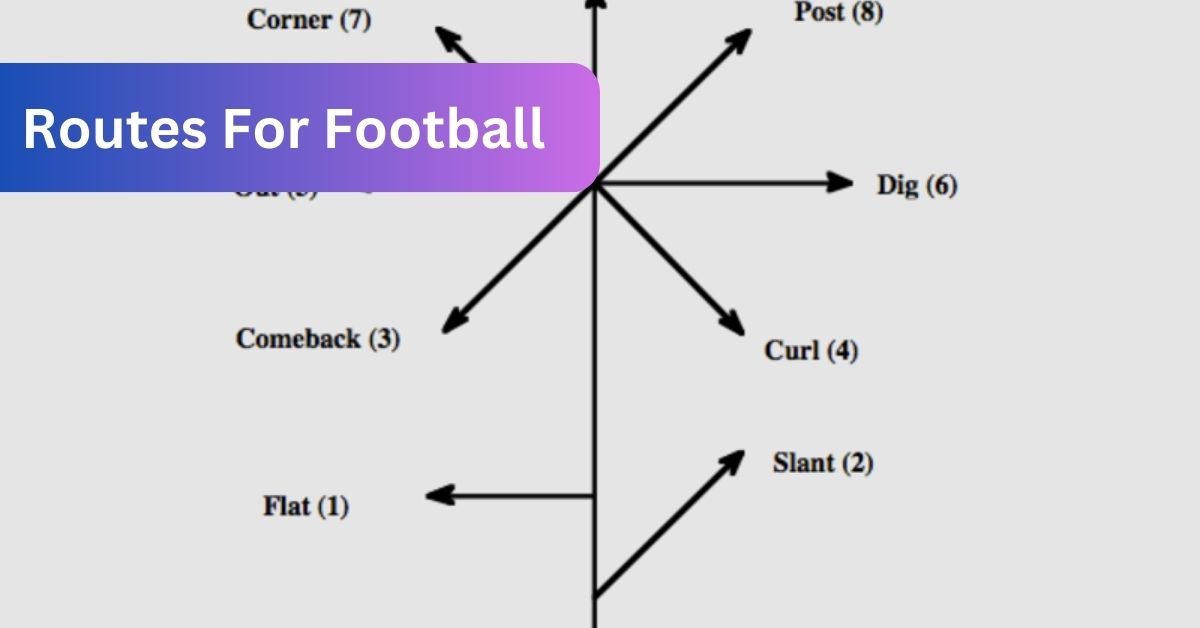Routes For Football – All You Need To Know!
Welcome to the world of football routes, where plays become like dance moves on the field. Imagine the explosive speed of a fly route or the tricky turns of a pivot route—each play has its unique style. These routes are like secret codes between quarterbacks and receivers, a way for them to communicate without saying a word.
Football routes are strategic plays where receivers follow specific paths to outmaneuver defenders and create scoring opportunities for the team.
“Unlocking football’s secret language—routes. Let’s follow us!
What Is Curl Route – Let’s Learn!
The curl route in football is a strategic and versatile play that adds a layer of complexity to offensive game plans.
It involves the receiver sprinting downfield, creating separation from the defender, and then executing a sharp, often 90-degree, turnaround toward the quarterback. The success of the curl route hinges on precise timing and coordination between the receiver and the quarterback.
This route is particularly effective against man-to-man coverage, leaving defenders trailing, and it’s a valuable tool for exploiting soft spots in zone defences. Designed for moderate gains in yardage, the curl route requires receivers to master the art of precise route running, reading the defence, and maintaining fluidity in movement.
Coaches often incorporate this play into their playbooks due to its reliability and ability to counteract various defensive strategies. Whether you’re a player refining your skills or a coach seeking a strategic edge, mastering the curl route opens up new dimensions of offensive prowess on the football field.
Comeback Route – Here To Know!

The key to the comeback route’s success lies in its ability to deceive defenders, especially those playing in man-to-man coverage. The sudden change in direction catches defenders off guard, allowing the receiver to create separation and position themselves for a well-timed pass from the quarterback.
This route is particularly effective for intermediate gains and can be a reliable option in critical third-down situations.
A receiver’s mastery of the comeback route requires impeccable running, reading the defence, and maintaining a connection with the quarterback. Coaches appreciate its versatility, using it as a countermeasure against aggressive defensive plays.
Drag Route – Here To Check!
The drag route, a staple in football strategy, is a dynamic play designed to exploit defensive vulnerabilities and create strategic advantages for the offence. Typically run by slot receivers or tight ends, the drag route involves the receiver crossing the field horizontally at a shallow depth, parallel to the line of scrimmage.
This lateral movement makes it challenging for defenders to maintain coverage, especially in zone defences. The drag route is known for its versatility, offering a quick and reliable option for the quarterback, especially in fast-paced, short-yardage situations.
Timing is crucial, and a well-executed drag route confounds defenders and creates opportunities for yards after the catch. Receivers must demonstrate agility and precise route running to navigate traffic effectively. Coaches often incorporate the drag route as part of a strategic offensive scheme, using its simplicity to mask more complex plays and keep the defence guessing.
Shallow Cross Route – Gain Your Knowledge!

Typically executed by slot receivers or agile running backs, this route involves a player starting on one side of the field and sprinting horizontally at a shallow depth to the opposite side.
The shallow cross route is designed to take advantage of both man-to-man and zone defenses, forcing defenders to navigate through traffic or make quick decisions in coverage. This play is particularly effective for gaining moderate yardage and creating opportunities for yards after the catch.
A well-timed shallow cross route demands precision from both the receiver and the quarterback, as the play’s success relies on perfect synchronisation. Coaches appreciate the versatility of the shallow cross, often incorporating it into offensive schemes to exploit defensive weaknesses and keep opponents on their toes.
Fly Route – Let’s Read!
The fly route, a blazing streak of speed and precision in football strategy, is a dynamic play designed to exploit a receiver’s pure speed and stretch the field vertically.
Also known as a “go route” or “streak,” the fly route involves the receiver sprinting straight down the field at full throttle, aiming to outrun defenders and create a deep passing option for the quarterback.
This play is a testament to the importance of speed in football, as the receiver aims to beat defenders in a foot race, positioning themselves for a potentially explosive touchdown play.
The success of the fly route relies on the perfect synchronisation between the quarterback’s powerful arm and the receiver’s ability to create separation.
Often used to capitalise on a speed advantage or catch a defence off guard, the fly route is a high-risk, high-reward play that can turn a game’s momentum in an instant. Coaches strategically deploy the fly route to stretch the defence, open up other areas of the field, and keep opposing teams on edge.
Post Route – Explore It Out!

The post route is designed to exploit the vulnerabilities in both man-to-man and zone coverage, creating a window of opportunity for the quarterback to deliver a precise and powerful pass.
Its success hinges on the receiver’s ability to deceive defenders with the initial sprint before swiftly changing direction. The post route is particularly effective for targeting the heart of the defence, often resulting in long gains or touchdown receptions.
Coaches integrate the post route strategically into their playbooks, recognising its ability to keep defences on their toes and open up the field for other offensive plays.
Jerk Route – Go In Depth!
This route begins with the receiver making a sudden, convincing stop in their forward motion, mimicking the appearance of a short or intermediate route.
However, the deception lies in the abrupt continuation of the route, as the receiver accelerates back into a full sprint, leaving the defender in their wake. The jerk route is particularly effective against aggressive cornerbacks or in situations where the defence anticipates a shorter play.
Timing and precise route running are paramount, as the success of the play relies on the receiver’s ability to sell the initial stop convincingly.
Coaches integrate the jerk route strategically into their playbooks, leveraging its deceptive nature to create separation and exploit defensive misreads.
Frequently Asked Questions(FAQs):
1. What is the most effective route for gaining short yardage?
Opt for quick out or hitch routes for swift short-yardage gains; a sideline cut offers a reliable target for the quarterback.
2. How can a receiver improve their route-running skills?
Improve route-running through agility drills, film study, and collaboration with coaches.
3. Are there routes designed explicitly for beating zone defences?
Dig, or curl routes effectively exploit zone defences by targeting open areas not covered by defenders.
Conclusion:
At the end of the article,
Football routes involve receivers strategically navigating specific paths to outsmart defenders, crafting opportunities to score for the team.
READ MORE:






